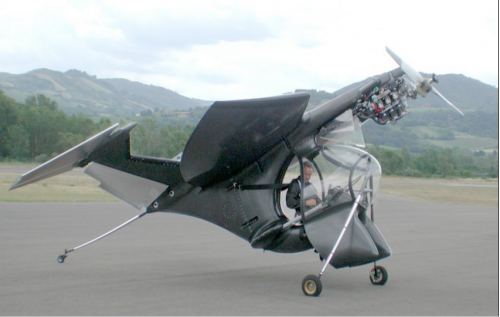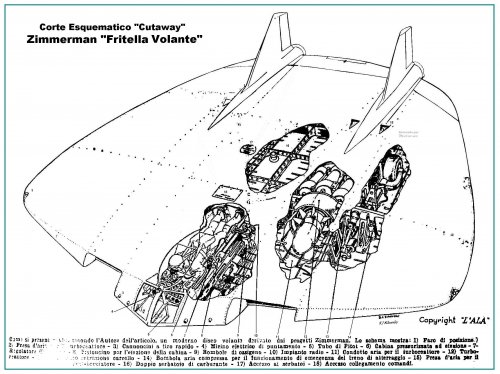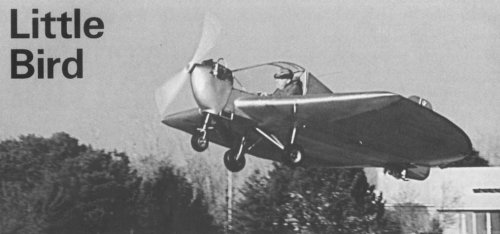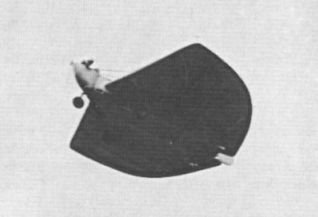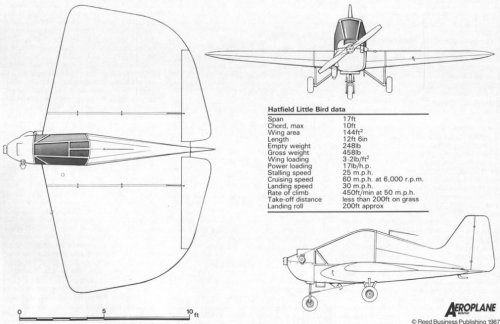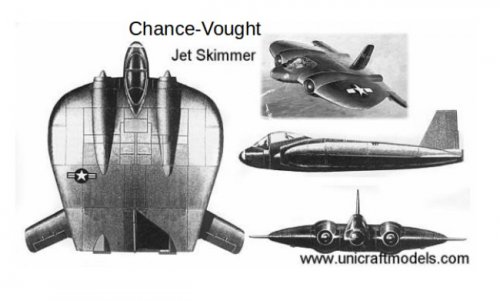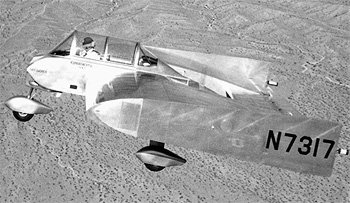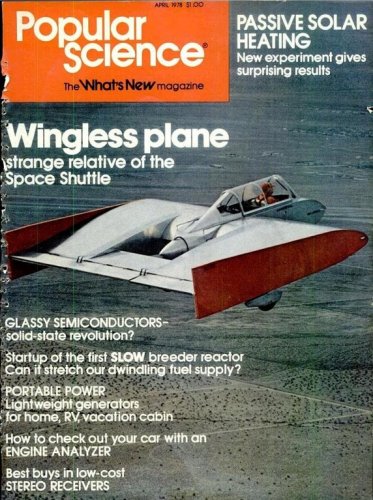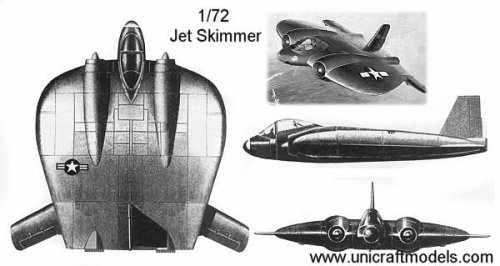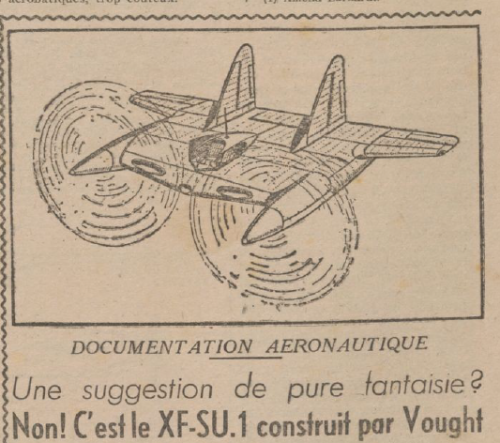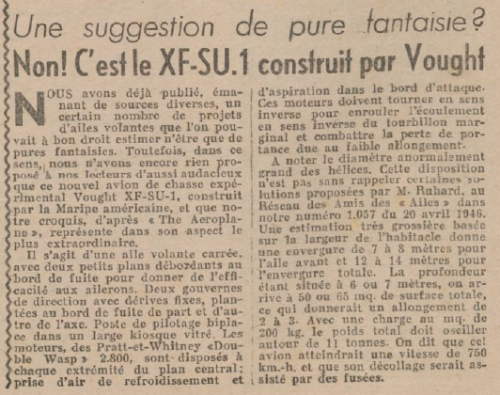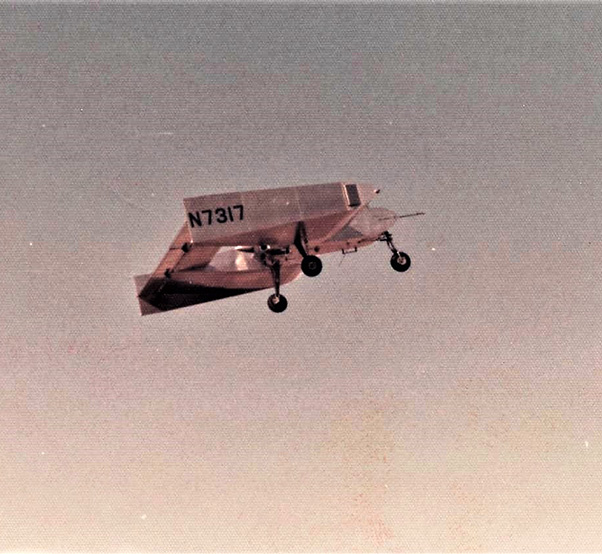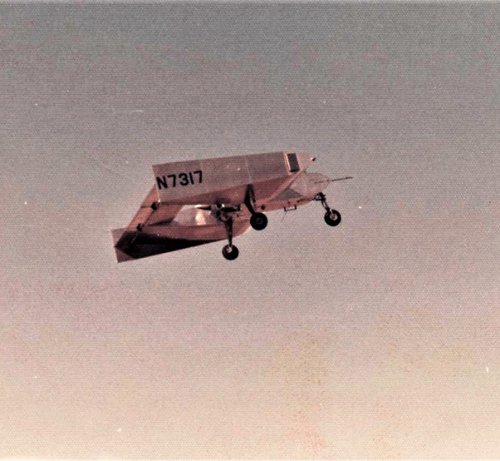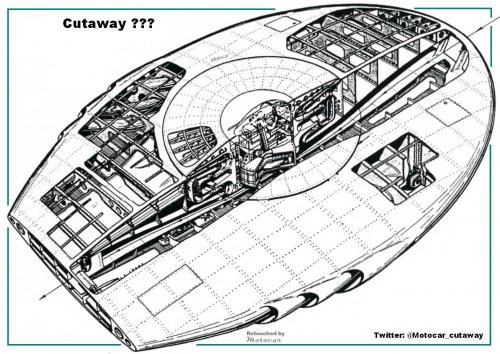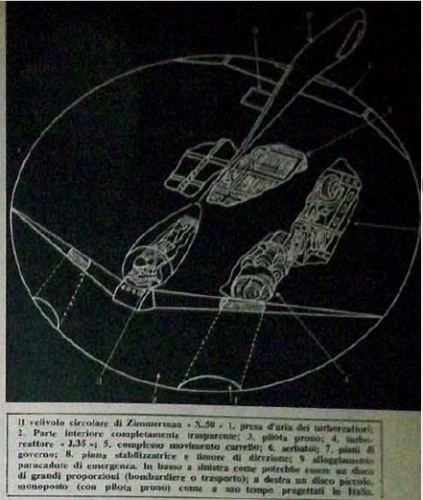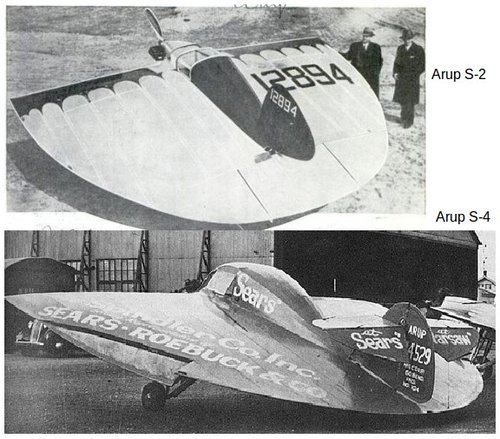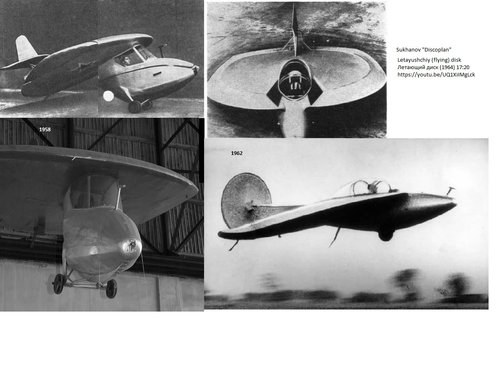You are using an out of date browser. It may not display this or other websites correctly.
You should upgrade or use an alternative browser.
You should upgrade or use an alternative browser.
Flying Flapjacks
- Thread starter cluttonfred
- Start date
- Joined
- 26 May 2006
- Messages
- 34,901
- Reaction score
- 15,761
Avimimus said:A fairly new very low aspect ratio design for a single seat ESTOLL touring aircraft:
http://pietroterzi.com/site/pro/lucy.htm
Is it a real one ?.
Attachments
- Joined
- 26 May 2006
- Messages
- 34,901
- Reaction score
- 15,761
robunos said:Doing a bit more digging, it seems that Milt Hatfield built 3 Little Birds in total, each one differing from the others. #2 and #3 incorporated fibreglass in their construction, to varying degrees. All three still survive, but not in flyable condition.
See here :-
http://www.oshkosh365.org/ok365_DiscussionBoardTopic.aspx?id=1235&boardid=147&forumid=180&topicid=4813
and here :-
http://www.homebuiltairplanes.com/forums/members/littlebird-albums-little-birds.html
cheers,
Robin.
Hi;
http://aviadejavu.ru/Site/Crafts/Craft34682.htm
Attachments
John Frazer
I really should change my personal text
- Joined
- 1 January 2018
- Messages
- 26
- Reaction score
- 40
The Vought/Zimmerman/Sikorsky effort might be called "Zimmerman's folly", or how the navy threw away a superior fighter, by not building the Boeing little 390 test plane, as a sincere follow-on to the performance of the Arup.
The Arup S-2 flew for NACA and the Army and CAA. Zimmerman worked for NACA and was on the team that saw the Arup fly. After that, his idea for a VTOL toy with short aspect-ratio and twin screws gelled. (his patents and his participation in that contest followed the successful careers of the Arup plane He plainly was following the interest overseas and here in low-aspect ratio, and the success of Arup gave him what he thought he needed for his VTOL experiments.)
But the Arup nor the V-173 did not need the giggle-factor-inducing silly huge flappy props over the wing-tips.
They were a distraction from the performances the Arup plane put on, they are an un-necessary over-complication, and in the XF5U they killed what could have been a good plane (simple twin-engine & prop plane would have flown, and probably done extraordinarily well if not for the complex power system for those wing-tip things).
Short aspect ratio planes do not suffer abnormally high drag due to wing-tip wash-around while in cruise. In cruise low-A flight, they are sleek, like a little all-wing. Several planforms of low aspect-ratio all-wing and unitary wing/body test planes have flown well.
In low speed high-A flight, the wing-tip vortices wrap around and join the air over the top of the wing, preventing it from separating and stalling. That gives them low aspect-ratio lanes their phenomenal low-speed, high-A performance, typically staying in flight slower than their landing speed, limited by the height of the nose wheel.
You don't want to counter it. You want the vortex-lift at low speeds, and it disappears in normal flight.
So, we might ask why the Navy chose to explore Zimmerman's toy, and ignored the Boeing plane (which appeared more sinister than silly). If followed-up with a flapjack fighter, it would have been like a Bearcat, with more speed, range, payload, and >40 kt landing speed. The planform would have taken over the fleet and pretty soon all military aviation. When the Arup patents expired, all aviation would have been using it.
The advent of the Jet Age didn't kill it. The Navy built and operated piston-prop planes for logistics & support and as tactical combat planes until the '70s.
The Vought jet-skimmer or the Sikorsky models would have been built instead of the P-80, and a supersonic version would have followed.
See the Eschelman "Flying Flounder" for a possibility of what such a thing might have looked like.
The Unicraft model kit is the only thing I can find online for this.
The follow on post about William Horton designs was split and merged with the older thread here:
https://www.secretprojects.co.uk/forum/index.php/topic,5996.msg326793.html#msg326793
The Arup S-2 flew for NACA and the Army and CAA. Zimmerman worked for NACA and was on the team that saw the Arup fly. After that, his idea for a VTOL toy with short aspect-ratio and twin screws gelled. (his patents and his participation in that contest followed the successful careers of the Arup plane He plainly was following the interest overseas and here in low-aspect ratio, and the success of Arup gave him what he thought he needed for his VTOL experiments.)
But the Arup nor the V-173 did not need the giggle-factor-inducing silly huge flappy props over the wing-tips.
They were a distraction from the performances the Arup plane put on, they are an un-necessary over-complication, and in the XF5U they killed what could have been a good plane (simple twin-engine & prop plane would have flown, and probably done extraordinarily well if not for the complex power system for those wing-tip things).
Short aspect ratio planes do not suffer abnormally high drag due to wing-tip wash-around while in cruise. In cruise low-A flight, they are sleek, like a little all-wing. Several planforms of low aspect-ratio all-wing and unitary wing/body test planes have flown well.
In low speed high-A flight, the wing-tip vortices wrap around and join the air over the top of the wing, preventing it from separating and stalling. That gives them low aspect-ratio lanes their phenomenal low-speed, high-A performance, typically staying in flight slower than their landing speed, limited by the height of the nose wheel.
You don't want to counter it. You want the vortex-lift at low speeds, and it disappears in normal flight.
So, we might ask why the Navy chose to explore Zimmerman's toy, and ignored the Boeing plane (which appeared more sinister than silly). If followed-up with a flapjack fighter, it would have been like a Bearcat, with more speed, range, payload, and >40 kt landing speed. The planform would have taken over the fleet and pretty soon all military aviation. When the Arup patents expired, all aviation would have been using it.
The advent of the Jet Age didn't kill it. The Navy built and operated piston-prop planes for logistics & support and as tactical combat planes until the '70s.
The Vought jet-skimmer or the Sikorsky models would have been built instead of the P-80, and a supersonic version would have followed.
See the Eschelman "Flying Flounder" for a possibility of what such a thing might have looked like.
The Unicraft model kit is the only thing I can find online for this.
The follow on post about William Horton designs was split and merged with the older thread here:
https://www.secretprojects.co.uk/forum/index.php/topic,5996.msg326793.html#msg326793
Attachments
Motocar
I really should change my personal text
- Joined
- 16 May 2014
- Messages
- 1,083
- Reaction score
- 1,140
- Joined
- 4 May 2008
- Messages
- 2,439
- Reaction score
- 762
AeroFranz said:Oh, sorry for misunderstanding
The flapping of the blades might have been necessary because at high angles of attack the props are operating in a strong edgewise flow (not unlike a helicopter rotor). The advancing and retreating blades see differing inflow velocity and need to flap to balance thrust across the disc.
Maybe someone else has a better explanation?
I just came across this interesting video of Jack Reeder, longtime engineer and test pilot at Langley
at 48:30, he says there was little practical improvement with turning the props against the direction of the vortices. He also talks about the need to provide flapping motion for the propellers.
https://www.youtube.com/watch?v=HRZu78WozBo&feature=youtu.be
- Joined
- 2 August 2006
- Messages
- 3,255
- Reaction score
- 1,527
AeroFranz said:AeroFranz said:Oh, sorry for misunderstanding
The flapping of the blades might have been necessary because at high angles of attack the props are operating in a strong edgewise flow (not unlike a helicopter rotor). The advancing and retreating blades see differing inflow velocity and need to flap to balance thrust across the disc.
Maybe someone else has a better explanation?
I just came across this interesting video of Jack Reeder, longtime engineer and test pilot at Langley
at 48:30, he says there was little practical improvement with turning the props against the direction of the vortices. He also talks about the need to provide flapping motion for the propellers.
https://www.youtube.com/watch?v=HRZu78WozBo&feature=youtu.be
My understanding is that the problems with the flapping propellers is why the XF5U-1 was never flown.
- Joined
- 4 May 2008
- Messages
- 2,439
- Reaction score
- 762
IIRC, the prototype had F4U props, but there was always an understanding that it would get four-bladed teetering props. I think the decision to ax the program had more to do with the obsolescence of props versus jets.
- Joined
- 2 August 2006
- Messages
- 3,255
- Reaction score
- 1,527
AeroFranz said:IIRC, the prototype had F4U props, but there was always an understanding that it would get four-bladed teetering props. I think the decision to ax the program had more to do with the obsolescence of props versus jets.
I understand that, but I mean why they didn't just fly it for just the research. Of course, in that regard, I often wondered why they didn't just fly it with the F4U props, from a research standpoint.
- Joined
- 4 May 2008
- Messages
- 2,439
- Reaction score
- 762
Amen, brother. I'm sure there were some interesting lessons to be had from flying a novel configuration...although to be fair, they had tunnel-tested and flown the V-173.
I checked the references i have on the XF5U. The props were supposed to be Hamilton Standard four bladed teetering, especially designed for the vehicle. They weren't ready by the time the prototype was rolled out, so it was equipped with F4U Hydromatic units. Turns out it was a very poor match and they couldn't fly it like that. While waiting for the props, Zimmerman did some redesign based on lessons learned while ground testing. the cockpit was redesigned, and he added a trailing edge surface between the verticals.
I checked the references i have on the XF5U. The props were supposed to be Hamilton Standard four bladed teetering, especially designed for the vehicle. They weren't ready by the time the prototype was rolled out, so it was equipped with F4U Hydromatic units. Turns out it was a very poor match and they couldn't fly it like that. While waiting for the props, Zimmerman did some redesign based on lessons learned while ground testing. the cockpit was redesigned, and he added a trailing edge surface between the verticals.
- Joined
- 11 March 2012
- Messages
- 3,249
- Reaction score
- 3,179
They might have been able to fly it horizontally with F4U props, but could not have demonstrated any high angle of attack flight with conventional propellers. They also had problems with propeller vibration on the (fly able) mock-up.
GWrecks
Big Wingy Thingy
- Joined
- 15 July 2018
- Messages
- 76
- Reaction score
- 19
John Frazer said:The Vought/Zimmerman/Sikorsky effort might be called "Zimmerman's folly", or how the navy threw away a superior fighter, by not building the Boeing little 390 test plane, as a sincere follow-on to the performance of the Arup.
The Arup S-2 flew for NACA and the Army and CAA. Zimmerman worked for NACA and was on the team that saw the Arup fly. After that, his idea for a VTOL toy with short aspect-ratio and twin screws gelled. (his patents and his participation in that contest followed the successful careers of the Arup plane He plainly was following the interest overseas and here in low-aspect ratio, and the success of Arup gave him what he thought he needed for his VTOL experiments.)
But the Arup nor the V-173 did not need the giggle-factor-inducing silly huge flappy props over the wing-tips.
They were a distraction from the performances the Arup plane put on, they are an un-necessary over-complication, and in the XF5U they killed what could have been a good plane (simple twin-engine & prop plane would have flown, and probably done extraordinarily well if not for the complex power system for those wing-tip things).
Short aspect ratio planes do not suffer abnormally high drag due to wing-tip wash-around while in cruise. In cruise low-A flight, they are sleek, like a little all-wing. Several planforms of low aspect-ratio all-wing and unitary wing/body test planes have flown well.
In low speed high-A flight, the wing-tip vortices wrap around and join the air over the top of the wing, preventing it from separating and stalling. That gives them low aspect-ratio lanes their phenomenal low-speed, high-A performance, typically staying in flight slower than their landing speed, limited by the height of the nose wheel.
You don't want to counter it. You want the vortex-lift at low speeds, and it disappears in normal flight.
So, we might ask why the Navy chose to explore Zimmerman's toy, and ignored the Boeing plane (which appeared more sinister than silly). If followed-up with a flapjack fighter, it would have been like a Bearcat, with more speed, range, payload, and >40 kt landing speed. The planform would have taken over the fleet and pretty soon all military aviation. When the Arup patents expired, all aviation would have been using it.
The advent of the Jet Age didn't kill it. The Navy built and operated piston-prop planes for logistics & support and as tactical combat planes until the '70s.
The Vought jet-skimmer or the Sikorsky models would have been built instead of the P-80, and a supersonic version would have followed.
See the Eschelman "Flying Flounder" for a possibility of what such a thing might have looked like.
The Unicraft model kit is the only thing I can find online for this.
The follow on post about William Horton designs was split and merged with the older thread here:
https://www.secretprojects.co.uk/forum/index.php/topic,5996.msg326793.html#msg326793
This seems more than a little fishy to me. For starters that jet F5U image posted is clearly a shooped version of another one. Secondly, there is plenty of evidence that wingtip vortices exist, so unless the implication is that propellers can't do anything about it that's not really saying much. Lastly, it's worth noting that Convair had worked with a similar layout for their GETOL (Ground Effect Take-Off and Landing) proposals, so there's a convergent evolution process there too.
EDIT: Looks like it's not shopped after all, but the landing gear arrangement is clearly nonsensical (The only real changes were the removal of propellers and addition of jet nozzles, and it still uses the same landing gear!) and as a result I have trouble even imagining this was proposed.
Another thing worth mention, the F5U with piston engines would've been faster than most jet aircraft during WWII. There was a turboprop version suggested but I can't find images of it. All of this points (At least to me) in the direction of the propellers existing for a reason. Oh...
John Frazer said:The planform would have taken over the fleet and pretty soon all military aviation. When the Arup patents expired, all aviation would have been using it.
...This is bait, isn't it?
John Frazer
I really should change my personal text
- Joined
- 1 January 2018
- Messages
- 26
- Reaction score
- 40
The fact remains that no appreciable benefit to the Vought 173 or XF5U outward-turning props was found, and the Arups, the Nemeth, the Little Bird, and the Facetmobile all get the same extreme STOL and slow-flight performance without worrying about that myth.
Nemeth had equal or greater speed compared to the biplane. It was not extraordinarily draggy.
The outward turning props of the Vought/Zimmerman experiment didn't stop the extreme wingtip vortices; if they had, it would not have been capable of such slow speeds. That it was capable of slow speeds shows that they didn't effectively counter it. It's nonsensical to even think of trying to do so. That's not what Zimmerman was after.
That other similar-planform planes flew with a normal prop in the center (whether round or delta, whether as parasol wing or integral wing/body) shows that the vortices and the attendant STOL performance are due solely to the "parachute lift" effect, not the outward-turning props.
Jets would have worked just fine if speed was desired, or props for a slower plane. The Navy in '52 built the S-2, followed by the C-1, with piston-props. The advent of the "jet age" didn't stop them or the A1 from being extremely useful. An adaptation of the F5 type planform with the normal S-2 engines and props installed would have been faster, with more payload, and the STOL landing speed if it had suitable landing gear for nose-up attitude.
The Italian language articles show one by Sergei Sikorsky, aircraft engineer, son of Igor, who worked for Vought on the Zimmerman planes. He apparently knew that it didn't need or make any appreciable use of the extravagant and complex Zimmerman props. Suitable landing gear would have allowed it STOL performance and made it a very clean and useful all-wing -plus fins.
According to the Arup and Little Bird and (possibly applicable the Facetmobile) experience, entirely stable and controllable, fast.
In one of the videos of Hatfield and his Little Birds, he congratulates Rutan on the success of the Voyager, and then challenges that if it had been built to the Arup short aspect-ratio all-wing, it would have been lighter, faster, more useful interior room, and made the flight with plenty of fuel to spare.
This doesn't sound like the draggy monster which "conventional wisdom" says low-aspect-ratio to be. Are we here saying that Hatfield was lying/exaggerating/deluded? The Arup 2 was ~900 lbs, 97mph on 37 horsepower (thirty-seven). That also doesn't sound draggy and inefficient.
All discussion of low aspect ratio and the alleged high parasitic or induced drag and "terrible span efficiency" refers to the extreme huge wing-tip vortex drag, as it it follows them around all the time. It simply isn't true.
Feel free to consider it bait, to say that a sensible evolution of the Arup as a navy plane, whether as a escort-carrier fighter or the up and coming A1 or A2d Skyshark, or the S-2/C1 series, would have benefitted. Would the evolution of planes after the war have been different without the various persistent myths and misconceptions surrounding the round wing extremely short aspect ratio?
Nemeth had equal or greater speed compared to the biplane. It was not extraordinarily draggy.
The outward turning props of the Vought/Zimmerman experiment didn't stop the extreme wingtip vortices; if they had, it would not have been capable of such slow speeds. That it was capable of slow speeds shows that they didn't effectively counter it. It's nonsensical to even think of trying to do so. That's not what Zimmerman was after.
That other similar-planform planes flew with a normal prop in the center (whether round or delta, whether as parasol wing or integral wing/body) shows that the vortices and the attendant STOL performance are due solely to the "parachute lift" effect, not the outward-turning props.
Jets would have worked just fine if speed was desired, or props for a slower plane. The Navy in '52 built the S-2, followed by the C-1, with piston-props. The advent of the "jet age" didn't stop them or the A1 from being extremely useful. An adaptation of the F5 type planform with the normal S-2 engines and props installed would have been faster, with more payload, and the STOL landing speed if it had suitable landing gear for nose-up attitude.
The Italian language articles show one by Sergei Sikorsky, aircraft engineer, son of Igor, who worked for Vought on the Zimmerman planes. He apparently knew that it didn't need or make any appreciable use of the extravagant and complex Zimmerman props. Suitable landing gear would have allowed it STOL performance and made it a very clean and useful all-wing -plus fins.
According to the Arup and Little Bird and (possibly applicable the Facetmobile) experience, entirely stable and controllable, fast.
In one of the videos of Hatfield and his Little Birds, he congratulates Rutan on the success of the Voyager, and then challenges that if it had been built to the Arup short aspect-ratio all-wing, it would have been lighter, faster, more useful interior room, and made the flight with plenty of fuel to spare.
This doesn't sound like the draggy monster which "conventional wisdom" says low-aspect-ratio to be. Are we here saying that Hatfield was lying/exaggerating/deluded? The Arup 2 was ~900 lbs, 97mph on 37 horsepower (thirty-seven). That also doesn't sound draggy and inefficient.
All discussion of low aspect ratio and the alleged high parasitic or induced drag and "terrible span efficiency" refers to the extreme huge wing-tip vortex drag, as it it follows them around all the time. It simply isn't true.
Feel free to consider it bait, to say that a sensible evolution of the Arup as a navy plane, whether as a escort-carrier fighter or the up and coming A1 or A2d Skyshark, or the S-2/C1 series, would have benefitted. Would the evolution of planes after the war have been different without the various persistent myths and misconceptions surrounding the round wing extremely short aspect ratio?
Attachments
- Joined
- 25 June 2014
- Messages
- 1,564
- Reaction score
- 1,499
The fact remains that no appreciable benefit to the Vought 173 or XF5U outward-turning props was found, and the Arups, the Nemeth, the Little Bird, and the Facetmobile all get the same extreme STOL and slow-flight performance without worrying about that myth.
My understanding of the counter-vortex props at low speeds was primarily to improve l/d by reducing vortex drag. Vortices may be great lifters at high AoA but they carry a high induced drag penalty. For cruise where the tip vortices reduce the net lift and add drag. Simple washout drastically reduces net lift during cruise, so a much bigger wing with higher weight is needed to lift the same payload.
In lo-V hi-A flight, the XF5U props were designed to provide a net sidethrust in a vertical direction, aka lift. They achieved this through cyclic pitch variation. In a simple scheme, the angle of the rotation axis to the airstream provides the pitch variation, in a more complex scheme the blades are variable rather like a helicopter's are. As I recall, the 173 relied on the AoA while the XF5U had the full monty: in engineering terms its props were more like rotors than conventional props, however they acted as a variant known as a radial-lift rotor. For more about lifting rotors in general, I recommend Foshag, W.F. and Boehler, G.D.; "Review and Preliminary Evaluation of Lifting Horizontal-Axis Rotating-Wing Aeronautical Systems (HARWAS)", Aerophysics Co., 1969, http://www.dtic.mil/dtic/tr/fulltext/u2/857462.pdf
I speculate that Zimmerman may have calculated that any loss of vortex lift would have been compensated by the lifting props, with the reduction in vortex drag outweighing the additional power needed to drive the hard-working props.
But the truth is always in the testing. Failing to fly the XF5U as a pure research craft once all that money had been spent building it was an incredible wasted opportunity.
Cutaway Flying Saucer ???, author unknow an retouched by Motocar
This is not a circular aircraft. This is said to be an A.V. Roe of Canada design. A version of their Project Y which was abandoned to build a circular aircraft.
John Frazer
I really should change my personal text
- Joined
- 1 January 2018
- Messages
- 26
- Reaction score
- 40
Again, trying to reduce the vortices is nonsensical. Under any circumstances. The understanding of it that says this was an intention is mistaken.
They're the specific design feature sought after by the low aspect ratio. They give it the super-slow ability. You wouldn't want to reduce it.
As its slow speed performance shows it didn't reduce the vortices anyway. By definition, it used them, not reduced them.
The extreme vortices and attendant drag goes away during cruise; there's no point in such complexity to reduce something that isn't there. If the complexity of the aledged lifting props was making it not work, and they were virtually certain to get a plane like the S-2 with more speed & payload and 35kts landing speed.
They ignored it in search of VTOL and the completely new theory of his.
It still makes poor sense to not just stick a couple of engines like the S-2 on it.
They're the specific design feature sought after by the low aspect ratio. They give it the super-slow ability. You wouldn't want to reduce it.
As its slow speed performance shows it didn't reduce the vortices anyway. By definition, it used them, not reduced them.
The extreme vortices and attendant drag goes away during cruise; there's no point in such complexity to reduce something that isn't there. If the complexity of the aledged lifting props was making it not work, and they were virtually certain to get a plane like the S-2 with more speed & payload and 35kts landing speed.
They ignored it in search of VTOL and the completely new theory of his.
It still makes poor sense to not just stick a couple of engines like the S-2 on it.
- Joined
- 25 June 2014
- Messages
- 1,564
- Reaction score
- 1,499
trying to reduce the vortices is nonsensical. Under any circumstances.
It is interesting to compare this unsupported opinion with a quote from Aeroplane Monthly posted earlier in this thread; "...full-scale wind tunnel tests at Langley Field indicated that the high induced drag of the low aspect ratio wing would be partially compensated for by the interaction of the large props rotating in opposite directions ahead of the wing. Wing tip vortices which cause loss of lift on conventional wings were nullified by having each propeller rotating counter to the vortices." As far back as 1905 John William Dunne abandoned the stable delta wing in favour of a more effificent high-aspect-ratio swept planform (source: Dunne Archive in the Science Museum. Also, letter to the President of the Aeronautical Society of Great Britain, 1905, Baden-Powell collection, National Aerospace Library). It is only those who seek high manoeuvrability or low supersonic form drag who must resort to lower aspect ratios. Eight years later Dunne also famously lectured to the Aeronautical Society of Great Britain; "But the aeroplane does these things, and if the theory does not give warranty to the practice, then it is the theory that is wrong" (Journal of the AeS, 1913). I am sure that the designers of modern jumbo jets would be fascinated to learn that their long-span, heavy and expensive wings with their vortex-reducing winglets are doubly unnecessary. But some supporting literature might help give credence to John's overturning of a hundred years of aerodynamic belief.
One might note that where designs such as Concorde do adopt a low aspect ratio with vortex lift at low speeds, the drag penalty of the vortices is enormous and requires supersonic-class thrust to maintain flight. Hence Concorde's noise problem during takeoff and landing. This was all exhaustively studied. By contrast, a few personal opinions to the contrary on the capabilities of some poorly-documented private experiments must face an uphill struggle to be taken seriously. It is hard to accept that supporting numbers exist.
Last edited:
John Frazer
I really should change my personal text
- Joined
- 1 January 2018
- Messages
- 26
- Reaction score
- 40
All writings by qualified scientists on the subject says the Vortexes on these sorts of planes are temporary and elective, something the pilot wishes to use to fly slowly.
They are the reason for the very short aspect ratio of the Arup, the Vought, the Nemeth, the Avro Canada / USAF "Project 606" and "Project Y", "Silverbug", "Project 1794", etc , the simultaneous USSR Sukhanov "Discoplan".
Yes, Zimmerman's props partially compensated for it, but not nearly all or not much, because the plane was able to fly in the same sort of Vortex effect as the Arups.
It did not gain significant STOL ability from the props, but rather from the planform.
Writings from Zimmerman and from NACA state this explicitly. He copied the planform from the Arup, to give his prop experiment a STOL platform to start from. He did not innovate the STOL ability with the props. Ignorance of the existence and nature of the Vortex or "parachute" lift effect leads to misunderstandings of what Zimmerman started with, and what he and other explorers of the very short aspect ratio planform were trying. This is not the opinion of some guy on the 'net.
It's strange to claim that in the Vought the props allowed the super-slow flight, but in the Nemeth and the Arups and the Facetmobile, the Sukhanov it was the planform.
All decent data says it was the planform, and all decent data says the extreme vortex-induced drag is only present when the pilot wills it, specifically to fly slowly.
This is shown in practice. If the theory is shown to have major holes, predictably exploited by these designers, the theory is wrong, not the history.
As Dunne said: "But the aeroplane does these things, and if the theory does not give warranty to the practice, then it is the theory that is wrong"
Yes, indeed. Theory taught in the 19-oughts and teens, notwithstanding.
Sukhanov
Letayushchiy (flying) disk
Летающий диск (1964) 17:20
https://youtu.be/UQ1XiIMgLck
They are the reason for the very short aspect ratio of the Arup, the Vought, the Nemeth, the Avro Canada / USAF "Project 606" and "Project Y", "Silverbug", "Project 1794", etc , the simultaneous USSR Sukhanov "Discoplan".
Yes, Zimmerman's props partially compensated for it, but not nearly all or not much, because the plane was able to fly in the same sort of Vortex effect as the Arups.
It did not gain significant STOL ability from the props, but rather from the planform.
Writings from Zimmerman and from NACA state this explicitly. He copied the planform from the Arup, to give his prop experiment a STOL platform to start from. He did not innovate the STOL ability with the props. Ignorance of the existence and nature of the Vortex or "parachute" lift effect leads to misunderstandings of what Zimmerman started with, and what he and other explorers of the very short aspect ratio planform were trying. This is not the opinion of some guy on the 'net.
It's strange to claim that in the Vought the props allowed the super-slow flight, but in the Nemeth and the Arups and the Facetmobile, the Sukhanov it was the planform.
All decent data says it was the planform, and all decent data says the extreme vortex-induced drag is only present when the pilot wills it, specifically to fly slowly.
This is shown in practice. If the theory is shown to have major holes, predictably exploited by these designers, the theory is wrong, not the history.
As Dunne said: "But the aeroplane does these things, and if the theory does not give warranty to the practice, then it is the theory that is wrong"
Yes, indeed. Theory taught in the 19-oughts and teens, notwithstanding.
Sukhanov
Letayushchiy (flying) disk
Летающий диск (1964) 17:20
https://youtu.be/UQ1XiIMgLck
Attachments
- Joined
- 2 August 2006
- Messages
- 3,255
- Reaction score
- 1,527
All writings by qualified scientists on the subject says the Vortexes on these sorts of planes are temporary and elective, something the pilot wishes to use to fly slowly.
They are the reason for the very short aspect ratio of the Arup, the Vought, the Nemeth, the Avro Canada / USAF "Project 606" and "Project Y", "Silverbug", "Project 1794", etc , the simultaneous USSR Sukhanov "Discoplan".
Yes, Zimmerman's props partially compensated for it, but not nearly all or not much, because the plane was able to fly in the same sort of Vortex effect as the Arups.
It did not gain significant STOL ability from the props, but rather from the planform.
Writings from Zimmerman and from NACA state this explicitly. He copied the planform from the Arup, to give his prop experiment a STOL platform to start from. He did not innovate the STOL ability with the props. Ignorance of the existence and nature of the Vortex or "parachute" lift effect leads to misunderstandings of what Zimmerman started with, and what he and other explorers of the very short aspect ratio planform were trying. This is not the opinion of some guy on the 'net.
It's strange to claim that in the Vought the props allowed the super-slow flight, but in the Nemeth and the Arups and the Facetmobile, the Sukhanov it was the planform.
All decent data says it was the planform, and all decent data says the extreme vortex-induced drag is only present when the pilot wills it, specifically to fly slowly.
This is shown in practice. If the theory is shown to have major holes, predictably exploited by these designers, the theory is wrong, not the history.
As Dunne said: "But the aeroplane does these things, and if the theory does not give warranty to the practice, then it is the theory that is wrong"
Yes, indeed. Theory taught in the 19-oughts and teens, notwithstanding.
Sukhanov
Letayushchiy (flying) disk
Летающий диск (1964) 17:20
https://youtu.be/UQ1XiIMgLck
Actually, you're mixing your metaphors, so to speak. The props do counteract the tip vortices. The reason the flapjack could fly so slow and stay airborne was due to the prop wash over large areas of the wing at slow speeds and high angles of attack, not vortex formation over the top of the wing.
The other low aspect ratio designs maintain lift, or more accurately, delay or prevent flow separation, using the vortices forming over the top of the wing from the tips, in an almost opposite situation to the delta, which gets the vortice from the apex. However, unlike the flapjack, they also incur a large drag penalty, just like a delta, as a result of this vortex formation. Of course, the flapjack had a drag penalty, simply due to the higher speed of the prop wash going over the wing, but that was a penalty it would pay more at high speeds than low.
- Joined
- 16 February 2013
- Messages
- 132
- Reaction score
- 605
The jet XF5U as said above, was a creation for a magazine and then picked up by Unicraft as a great model project that could be called “USA’46” only there was no original. One reason the Navy stayed with the Vought over Boeing was that they sponsored the V-173 which brought them great headlines, “Lindberg crashes flying pancake into sand dune” etc. as well as great magazine covers. Boone Guyton did the testing of the XF5U and made his high speed taxi tests at Stratford using F4U Corsair propellers as the flapping blades weren’t cleared for flight yet and weren’t needed for that flight test. On one of these the XF5U lifted off and he flew it the length of the runway. But the Navy contract specifically stated that Vought would NOT fly the aircraft. It was to be flown or trucked to Edwards for flight test. They didn’t want to jeopardize being paid so it was never recorded or announced. It was filmed though, and when Vought moved to Dallas all the films were placed in 55 gal drums for shipment. That drum was never seen again. Jerry Moran who did the history of Vought spent years trying to find the film. Art Shoeni, Voughts historian back then and Boone Guyton verified this to me as well.
Zimmerman was not pleased with the XF5U offspring of his V -173. He felt they went in the wrong direction. His intention was to build a VTOL aircraft to be used as a courier for ship to ship. Even after the end of the war and the decision to terminate the program Zimmerman wrote out a lengthy proposal to the Navy to secure the XF5U and modify it into a VTOL courier aircraft. But his proposal got no where. Another factor was the fact that the fighter desk had decided that they would be going to all jets. He wrote me in the ‘80’s that he was disgusted at having to fly to California to look at two prop driven fighters that stood 30’ in the air as he put it. Those were the XFY and XFV.
Zimmerman was not pleased with the XF5U offspring of his V -173. He felt they went in the wrong direction. His intention was to build a VTOL aircraft to be used as a courier for ship to ship. Even after the end of the war and the decision to terminate the program Zimmerman wrote out a lengthy proposal to the Navy to secure the XF5U and modify it into a VTOL courier aircraft. But his proposal got no where. Another factor was the fact that the fighter desk had decided that they would be going to all jets. He wrote me in the ‘80’s that he was disgusted at having to fly to California to look at two prop driven fighters that stood 30’ in the air as he put it. Those were the XFY and XFV.
- Joined
- 25 June 2014
- Messages
- 1,564
- Reaction score
- 1,499
Theory taught in the 19-oughts and teens, notwithstanding.
Indeed. The Science Museum archives reveal that Dunne had long had an interest in vortices. They were something of a fad of the day. His first idea was for a propulsion device which worked by placing the prop in a duct with deflectors at both ends, and blowing the working fluid (air or water) forward. The front deflector turned it to flow backwards along the outside of the hull and the rear deflector scooped it up again, creating a vortex ring. This was intended to induce rearward flow through friction with the surrounding fluid. He did not date his drawings but other factors (described in my hopefully forthcoming book) lead me to date them to around 1901. Another undated sketch shows a rotor blowing up under an umbrella-shaped wing to create the same downward outer ring and hence vertical lift. It may even have been the "marriage of the kite and the windmill" which was his first attempt at a flying machine and inspired by a compound helicopter of Jules Verne. He seems to have dropped the idea when Hiram Maxim told him (rightly, I suspect) that it wouldn't work. Certainly, his first model failed. When he later developed his tailless swept designs, he had learned a little more and still kept vortices in mind: the endplates on his biplanes were not intended as fins but winglets to reduce tip vortex losses.
Contemporary with those later planes was Kitchen's development in the US of the toroidal "ring wing" - a flapjack with a hole in the middle - which Cedric Lee in the UK employed Tilghman Richards to develop further. In this design, vortex flow over the rear wing, induced by the curvature of the front wing, was regarded as crucial for its low-speed performance. The type also proved remarkably stable, which was one of Kitchen's objectives all along (as was also true of Dunne). Quite how sophisticated Richards' understanding was, I do not know, but it would certainly have been less than perfect by modern standards.
Had WWI not intervened and Richards eventually become a museum curator (he designed the Dunne model on display in the Science Museum), the history of the stable/STOL aeroplane and our understanding of vortex lift might have evolved very differently.
On the Arup and similar types, we may note that these were all of relatively lightweight construction with no operational payload. To paraphrase an old saying, you can make pretty much anything fly if you make it light enough. As Concorde later became famous for demonstrating, once you load the thing up to any weight you need powerful engines to overcome the vortex drag and maintain an adequately short takeoff. This is especially important for carrier-borne operation and would not have been lost on Vought's Naval customer. For VTOL you need even more thrust. Perhaps all this was part of the reason why the XF5-U departed from Zimmerman's vision.
As the plane speeds up and reduces its angle of attack, the vortices retreat to the wing tips, much reducing in power and trailing progressively aft, thus also reducing both the lift and the drag they generate. "Temporary and elective" is one way of putting it. Such a machine can be quite lively once in the air, though not as efficient as a higher-aspect-ratio wing. Endplate effects aside, I wonder how much vortex theory found its way into the development of the Osprey's transitional flight modes.
- Joined
- 19 July 2016
- Messages
- 4,279
- Reaction score
- 3,464
- Joined
- 31 July 2013
- Messages
- 571
- Reaction score
- 1,181
Thanks Foo Fighter, couldn't imagine something this weird would have been overlooked!
- Joined
- 19 July 2016
- Messages
- 4,279
- Reaction score
- 3,464
What I find weid is the lack of proper documentation on this aircraft. I am pretty sure I have seen something in an Xf5U article but can I find it, doh.....
- Joined
- 11 March 2012
- Messages
- 3,249
- Reaction score
- 3,179
Boeing Project 390 is mentioned www.aerofiles.com
Firefinder
ACCESS: Top Secret
- Joined
- 5 October 2019
- Messages
- 1,048
- Reaction score
- 1,901
Found this while digging around for some imagines of the XF5U weapons hardpoints.
Tuft Studies of Chance Vought XF5U-1 Airplane Model
View: https://www.youtube.com/watch?v=5Gj_eFnFzpw&feature=emb_err_woyt
Tuft Studies of Chance Vought XF5U-1 Airplane Model
Scouthound
ACCESS: Restricted
- Joined
- 26 September 2020
- Messages
- 1
- Reaction score
- 0
Flyboyken, fantastic model; could you give some details about it, did you work from plans? How much power does it need versus similar sized models?I built this Boeing 390 some years ago and have flown it extensively. It is a large model, quite heavy, yet flies well with no bad characteristics. It is very easy to land as once an attitude for approach is set, it seems to hold this right down to flare. It is electric with actual counterrotating props and I can provide details if there is model interest.
John Frazer
I really should change my personal text
- Joined
- 1 January 2018
- Messages
- 26
- Reaction score
- 40
There was very much interest in and experience with such things, aside from Zimmerman's affectation for the props situated as they were, many had flown well.The pancake was unlike anything else flying at the time and might well have been shook in ways that were beyond the structural engineering knowledge of the day.
See the Arup S-2 and S-4. Piloted by Glen Doolittle (the famous racer's cousin) 2 performed for NACA in ~'33, and Zimmerman was on the team that saw it fly.
It did not exhibit any abnormal drag in cruise; the huge wing-tip vortices are elective and temporary, in order to fly slow. It and many other types argue against the commonly held misconception that very-low aspect-ratio planes must be draggy.
Between the 2 planes, they flew several season at air shows, multiple pilots including novices and the founder, a podiatrist Dr Snyder took his wife and his son up in the 4. Frequently carrying adverts to pay for shop and hangar space. The S-3 was wrecked in arson at the shop space. The 2 & 4 apparently flew on until the age of the airframe grounded them. The 2 is being restored in a museum, the 4 is gone, scrapped at the start of the war after sitting outside.
"Radical Wings and Wind Tunnels" says that NACA tests showed very little difference to aerodynamic performance or flight, in the direction of prop rotation. It got its STOL abilities solely from the planform, not the props. They did not increase or really affect the cruise speed.
Zimmerman writes that he studied it at NACA and found the aspect ratio very close to the Arup maximized the vortex-driven "parachute lift" to gain 3-4x the lift at such slow speeds. He chose that planform specifically to maximize the vortices - it makes no sense to then try to counter them, knowing that it's not at all necessary.
He was specifically working towards a VTOL tail sitter, using the Arup planform as the slow speed high "A" starting point.
See also the Nemeth of the mid '30s and the similar Farman 1020. Faster than the planes which the fuselage came from, super-STOL with amazing climb rate, stall-spin proof.
Then there's the Eshelman "flounder" of '42. 130 hp, 180 mph, super-STOL
William Stout, US, 1918 "Batwing". Flew well, but pilots declared it a failure for total lack of visibility...
in '34, Moskalyev suggested a very-low aspect-ratio SAM-4 "Sigma" fast fighter, but got no support. In the '40s, in response to American successes (Vought and Eshelman?) he got the go-ahead for the SAM-9 Strela "Arrow" test plane, which was fast and super-STOL.
Nikolas Roland Payen, working for mr. Aubrun in the '30s, built the successful AP-10
All of these account also for the continued interest in wartime Germany for Arthur Sack's circular plane, though the AS-6 couldn't even "hop". Probably not enough A built into the landing gear for "parachute lift". Hand-launched models flew well.
Attachments
-
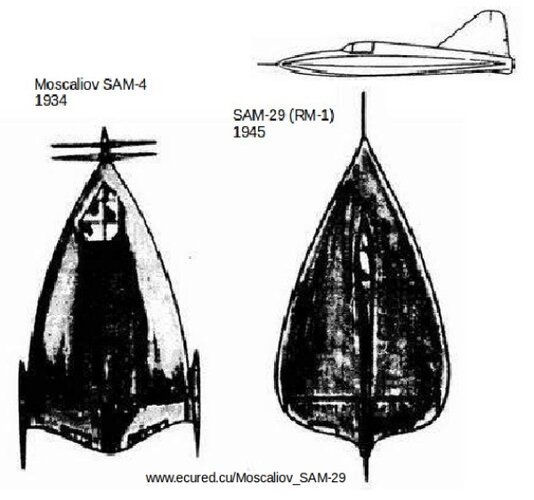 Moskalyev SAM-29.jpg136.5 KB · Views: 76
Moskalyev SAM-29.jpg136.5 KB · Views: 76 -
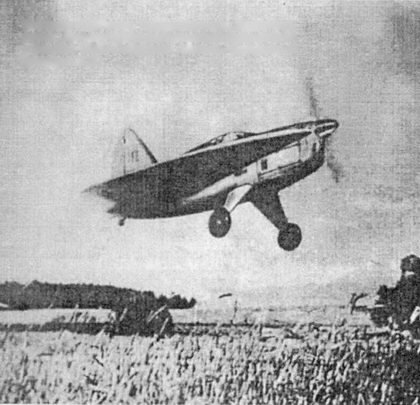 Moskalyev SAM-9 Strela_03.jpg37 KB · Views: 70
Moskalyev SAM-9 Strela_03.jpg37 KB · Views: 70 -
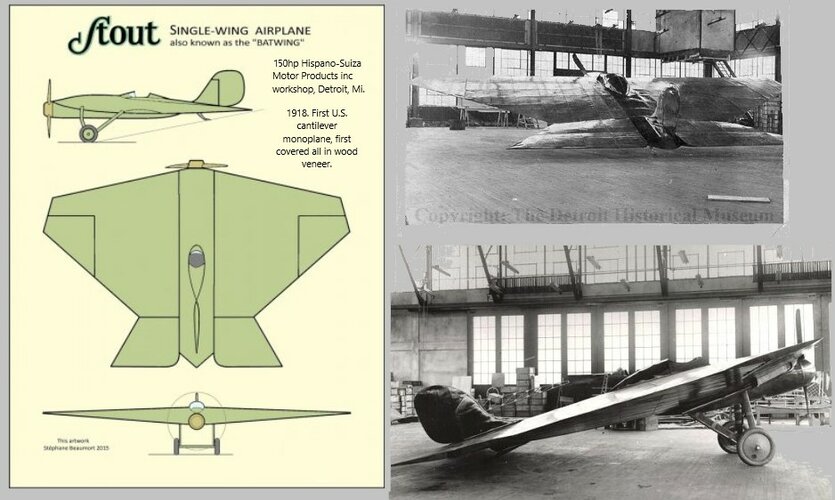 aero_Stout Batwing vampire_coomp.jpg120.1 KB · Views: 72
aero_Stout Batwing vampire_coomp.jpg120.1 KB · Views: 72 -
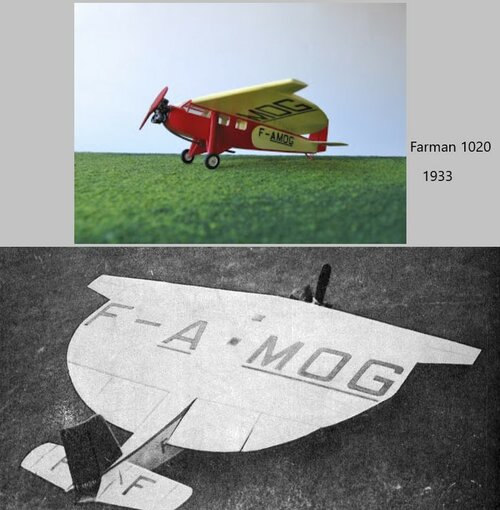 Farman 1020 comp.jpg105.2 KB · Views: 72
Farman 1020 comp.jpg105.2 KB · Views: 72 -
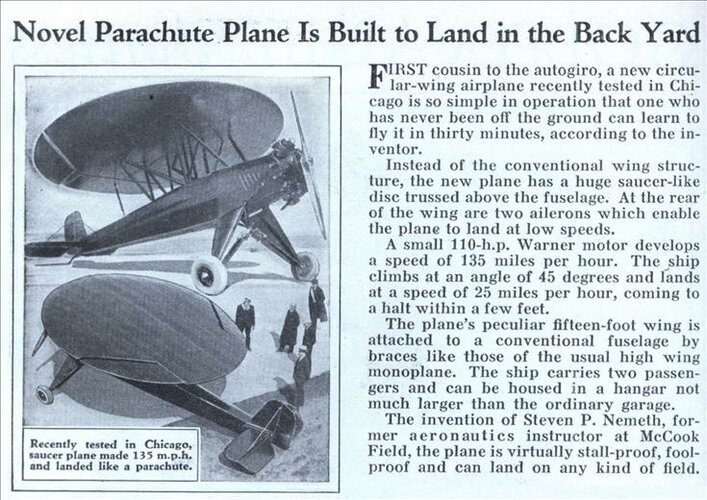 Nemeth_parachute_plane.jpg91.7 KB · Views: 78
Nemeth_parachute_plane.jpg91.7 KB · Views: 78 -
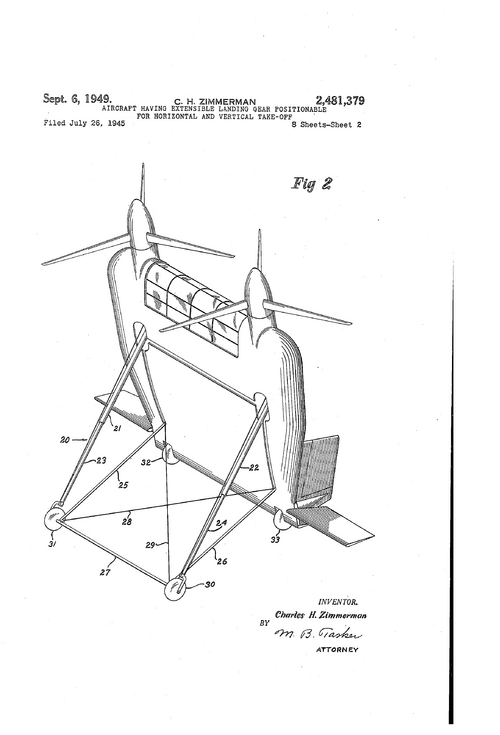 Zimmerman US2481379-1.png72.3 KB · Views: 75
Zimmerman US2481379-1.png72.3 KB · Views: 75 -
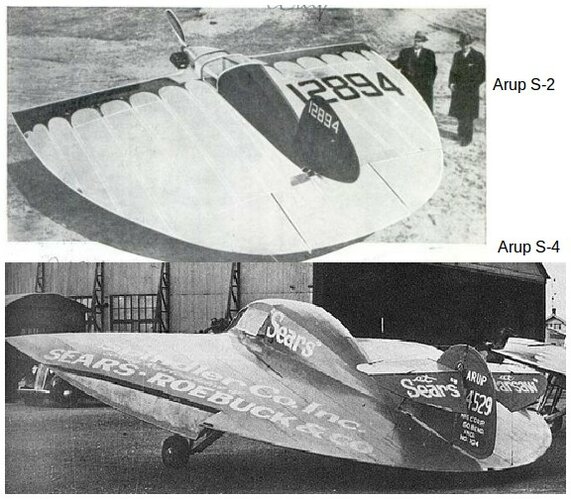 Arup.jpg99.3 KB · Views: 99
Arup.jpg99.3 KB · Views: 99 -
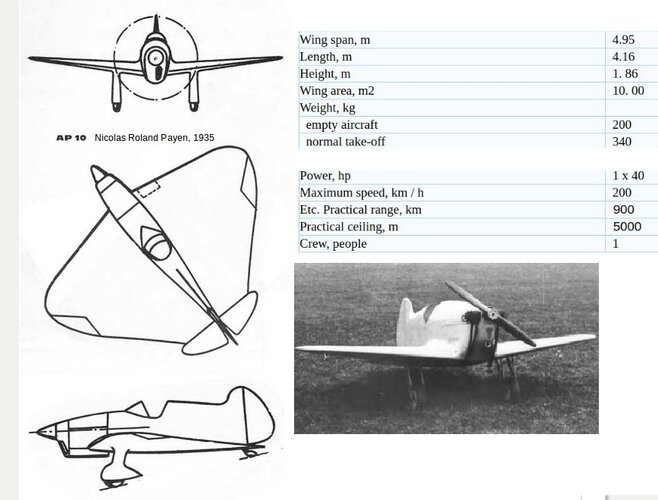 Payen AP-10_06.jpg102.3 KB · Views: 103
Payen AP-10_06.jpg102.3 KB · Views: 103
Last edited:
- Joined
- 25 June 2014
- Messages
- 1,564
- Reaction score
- 1,499
I don't think anybody here is challenging that these things fly, and can fly fairly well. Nor that getting up speed, and reaching a regime where the vortices retreat to the tips, is more efficient that full-blown vortex lift at high AoA.
But all the experience with low-aspect-ratio jets, from Lippisch to Lockheed to Concorde to the F-35, is that such subsonic cruise is still less efficient than for a high-aspect-ratio wing. The F-111 and Tornado did not have their wings locked in the low-aspect-ratio rearward position, they swung wide for subsonic flight, and for very good reason; to fly more efficiently. It has, frankly, been an unquestionable tenet of fundamental aerodynamics theory and practical confirmation for well over a hundred years.
These low-speed disc-type wings, including a homebuilt cropped delta with a lousy faceted aerofoil, might be accepted as better than awful, but I see no evidence presented whatsoever to support the extraordinary claim that they defy the thousands of practical measurements made over the years and achieve anything like normal levels of efficiency.
But all the experience with low-aspect-ratio jets, from Lippisch to Lockheed to Concorde to the F-35, is that such subsonic cruise is still less efficient than for a high-aspect-ratio wing. The F-111 and Tornado did not have their wings locked in the low-aspect-ratio rearward position, they swung wide for subsonic flight, and for very good reason; to fly more efficiently. It has, frankly, been an unquestionable tenet of fundamental aerodynamics theory and practical confirmation for well over a hundred years.
These low-speed disc-type wings, including a homebuilt cropped delta with a lousy faceted aerofoil, might be accepted as better than awful, but I see no evidence presented whatsoever to support the extraordinary claim that they defy the thousands of practical measurements made over the years and achieve anything like normal levels of efficiency.
- Joined
- 2 August 2006
- Messages
- 3,255
- Reaction score
- 1,527
The main difference, with regard to the above two posts is the speed regime. For a slow flying aircraft, one can gain good performance from the low aspect ratio wing, because while it's aerodynamic efficiency is low (See Aspect Ratio and Oswald Efficiency Factor) it can have a very efficient (thick) structure. So what you lose in aero efficiency you gain in structural efficiency. In fact, there was a very low aspect ratio Handley Page design that took advantage of this, but was never built. (It's on this site somewhere, the HP.126?) My understanding was that on short hops, city to city, it was competitive with standard designs. But on longer routes, it's lack of aerodynamic efficiency would have made it noncompetitive in the market. Also, the faster you go, the thinner a wing you want. So, that lives on in the form of the delta/ogive wing.
Similar threads
-
JThe Hurel-Dubois and Miles collaboration: Skyvan ancestors
- Started by joncarrfarrelly
- Replies: 9
-
Can anyone help me identify a prototype aircraft I remember but cannot find?
- Started by ThePolishAviator
- Replies: 0
-
Boeing Global Patrol Aircraft for USN
- Started by ChuckAnderson
- Replies: 26
-
USAF evaluation of the Boulton Paul « Balliol » trainer
- Started by Stargazer
- Replies: 9
-
NASA LCX proposal for Low-Cost Commercial Tranport aircarft of 1994
- Started by hesham
- Replies: 0

